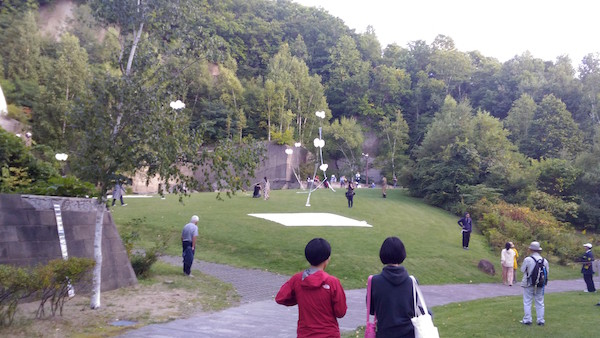What happens when you are an artist who has been given, say, five days, to make and present a new work for a site-specific event in a place that you have never seen before, in Japan?
You will be required to install your work anew each day, between 3 and 6.30pm. When it “starts to get dark”, you will participate in a sound performance and the sounds should be as “small” as possible. There will be an audience but they “may not be able to tell the difference between the exhibition and performance.”
On arrival, you discover the site is picturesque. It’s in a former soft-stone quarry, now a public park. Carpeted with vibrant green grass, fringed by rock walls, it is visited by breezes and gusty chilling winds. The early autumn sky is brilliantly blue. The Green Space is austerely beautiful, quiet and secluded.
Does it make your heart sink a little, seeing that the site is ‘perfect’ as it is, time is short, and you’re up against Mother Nature to make your artwork for Open Gate 2017 – an ever-changing exhibition, which brings together a group of 14 Japanese and Malaysian visual and sound artists to present works for four days at the Sapporo International Art Festival?
chi too, the Malaysian filmmaker and multidisciplinary artist, seemed to relish the challenge. When I saw him two hours before the official opening, he was cheerfully filling white balloons with helium. He said he wanted to create “columns” that would rise from the ground into the air. He attached long rolls of clingfilm to the balloons before releasing them. Scattered in the Green Space were the other artists doing their prep, including fellow Malaysian multimedia artist Adam Kitingan who was arranging little wooden boats that he had made by hand in Sapporo.

chi too’s work made me feel glad to have travelled by train, bus and on foot to get to the Green Space. His white balloons with long trails of clingfilm ‘tails’ evoked the ethereal despite being man-made materials which were foreign to the site. The swaying and sometimes violently shaken balloons and plasticky transparent clingfilm, set off against the rocks, trees, grass and sky, captured the invisible movements of breezes and winds in the site while accentuating its vertical dimension. As buoyant sculptures animated by moving air, they enlivened the space in a natural way which turned out to be very fun and calming to watch. The visuality was just stunning and captivating.
After making a tour of the works, I found that chi too’s work was different from the rest in that he was not using the site as a venue to display his work. He was trying to work in and with the Green Space, which actually proved to be a difficult site since it didn’t seem to need anything more than people enjoying it for what it was. It was also spacious and didn’t lend itself to being used as a ‘gallery’ to display an assortment of relatively small objects such as an altar-like arrangement of stuffed-toy cats against rocks, ritualistic-looking brass utensils on rocks, and little boats on the grass. There was also a big sheet of something lying on the grass which I couldn’t make out. (I learned after the event that it was actually an outline of Hokkaido island which was made into a kite, but it failed to take off.) The objects communicated little information and meaning in themselves, other than giving a sense of playfulness and/or ritualism. If I hadn’t spoken briefly with Adam Kitingan, for instance, I wouldn’t have known that his boats represented or alluded to the waves of migrants to his home state, Sabah.

At half past five or so, the artists began to make sounds in various ways using an assortment of found-on-site materials, like stones and sticks, and man-made objects such as metal trays and frequency devices that emitted buzzy noises. But it was difficult to fathom what it was they trying to do. More than that, it wasn’t fun or meaningful to watch a group of adults playing at improvising sounds with their chosen objects in a deliberately muted or restrained manner. chi too was using a toy accordion to make soft, random and squeaky sounds, in between minding his balloons and going to unentangle them from time to time. I wondered why he hadn’t made use of the diverse thudding sounds made by his balloons when they were buffeted by the wind. As it was, his installation was conceptually and excitingly site-specific, but the performance part was not.
For me, the event was an instance of the endemic difficulties of doing site-specific projects, especially when artists are put under intense pressure to find practical and imaginative ways to respond to a site in real time. Under the circumstances, it’s all too easy to forget about the audience, which would defeat one of the aims of doing site-specific art projects: to connect art directly with people.
About the author(s)
Leow Puay Tin is a playwright and text curator who collaborates with directors, actors, and other practitioners in making reality-based performance works, besides creating her own texts for performance. She also teaches at the School of Arts in Sunway University in Malaysia.

